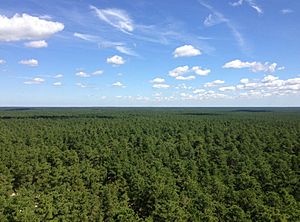South Jersey facts for kids
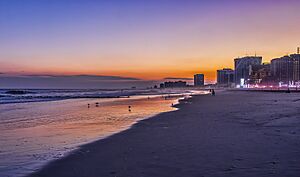
South Jersey is the southern part of the U.S. state of New Jersey. It's located between Pennsylvania and the lower Delaware River to its west, the Atlantic Ocean to its east, Delaware to its south, and either Central Jersey or North Jersey to its north, depending on how you define the northern part.
South Jersey is part of the Delaware Valley, a large area with over 6 million people. It's special because it has a unique natural area called the Pine Barrens. This huge forest is mostly untouched, even though it's close to many big cities. It's the biggest example of the Atlantic coastal pine barrens ecosystem left.
Benjamin Franklin once joked that New Jersey was "a barrel tapped at both ends." He meant that South Jersey was influenced by Philadelphia, while North Jersey was influenced by New York City. South Jersey is often thought of as the area below I-195. It includes seven main counties: Atlantic, Burlington, Camden, Cape May, Cumberland, Gloucester, and Salem. Sometimes, Ocean County is also included.
South Jersey is a key spot on the U.S. East Coast for logistics (moving goods) and building warehouses. Some parts of South Jersey are also home to people who work in the oil and gas industry in nearby Delaware. The South Jersey shore towns, like Atlantic City, are big tourist spots, famous for their beaches and fun activities. Many people from Burlington, Camden, and Gloucester counties travel to Philadelphia for work, as it's just across the Delaware River. You can get there using bridges like the Benjamin Franklin Bridge and Walt Whitman Bridge.
The name "South Jersey" is more of a common way to describe the area, not an official boundary. It shows that people feel there are differences in geography and culture between South Jersey and the northern part of the state.
Contents
- Exploring South Jersey's Geography
- Counties of South Jersey
- Major Cities and Areas
- South Jersey's Population
- A Look at South Jersey's History
- Economy and Living in South Jersey
- Colleges and Universities
- Sports in South Jersey
- Shopping and Resorts
- Media in South Jersey
- Famous People from South Jersey
- Culture and Unique Spots
- South Jersey English: How People Talk Here
Exploring South Jersey's Geography
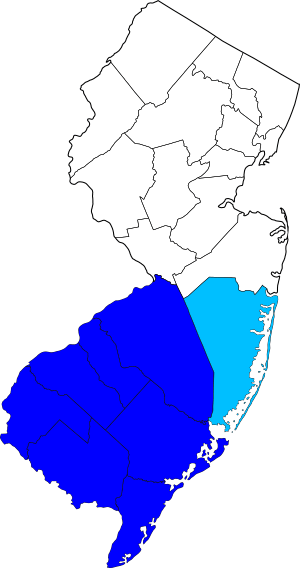
Landforms and Natural Areas

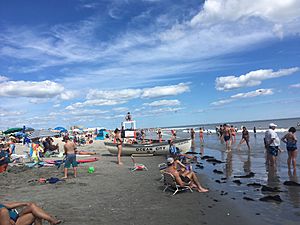
South Jersey is like a peninsula, with the Atlantic Ocean to its southeast, the Delaware Bay to its southwest, and the Delaware River to its northwest. All of South Jersey is part of the Atlantic Plain, which is a flat area with gentle hills that stretches all the way down to Florida.
Much of this plain is covered by pine and oak forests, and salt marshes. The land is made of soft sediment (like sand and clay) from ancient times. This area can be divided into three main parts:
- Inner Lowlands: This low valley along the Delaware River is very fertile, meaning it's great for farming. Its elevation is usually between 50 and 100 feet (15 to 30 meters).
- Outer Lowlands: This area near the Atlantic Ocean is mostly made up of coastal estuaries (where rivers meet the sea), swamps, and barrier islands. It's generally not good for farming and is usually less than 50 feet (15 meters) high.
- Central Uplands: This part is home to the New Jersey Pine Barrens. It has rolling hills, usually over 50 feet (15 meters) high but rarely over 200 feet (60 meters). The soil here is sandy and acidic, which isn't good for most crops. However, special fruits like cranberries and blueberries grow well in the wet, organic soil of the Pine Barrens.
South Jersey's Climate
South Jersey has a humid subtropical climate. This means it has warm, humid summers and mild winters. Compared to northern New Jersey, South Jersey usually has slightly warmer temperatures and a bit less rain each year. Along the Jersey Shore, the temperatures are kept milder by cool sea breezes coming off the ocean.
Counties of South Jersey
The following seven counties are fully part of South Jersey:
- Atlantic County
- Burlington County
- Camden County
- Cape May County
- Cumberland County
- Gloucester County
- Salem County
Sometimes, the southern part of Ocean County is also included in South Jersey. A poll in 2015 showed that many people consider towns like Barnegat and Tuckerton in Ocean County to be part of South Jersey.
Major Cities and Areas
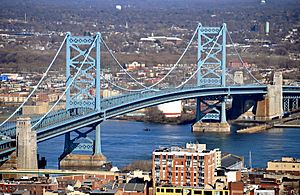
Key Cities in South Jersey
Camden, located across the Delaware River from Philadelphia, has always been an important economic center for South Jersey. It grew a lot because it was close to Philadelphia and was a major transportation hub. After World War II, Camden faced tough times as factories closed and people moved to the suburbs.
Today, Camden is home to the headquarters of Campbell's Soup and has important schools like Rutgers University–Camden and Cooper Medical School of Rowan University. The Camden Waterfront is a popular attraction with great views.
Nearby, Cherry Hill is the second-largest town in South Jersey and a big economic hub. It's a modern "edge city" with lots of businesses. The Pureland Industrial Complex, one of the largest industrial parks in the country, is also in South Jersey, close to Camden's port.
Atlantic City is a huge tourist spot, famous for its beaches, boardwalk, and casino gambling. It's on Absecon Island along with other towns like Ventnor City. Atlantic City became a resort town in 1854 when trains made it easy for people from Philadelphia to visit the beach. The world's first boardwalk opened here in 1870. After New Jersey allowed casino gambling in 1976, Atlantic City became the first place in the Eastern United States to have legal casinos. It's now the second-largest casino gaming market in the U.S., after Las Vegas.
Metropolitan Areas
Many counties in South Jersey are part of larger metropolitan areas. For example, Burlington, Camden, and Gloucester Counties are part of the Camden metropolitan area, which is connected to the bigger Philadelphia–Camden–Wilmington area.
Atlantic City and its surrounding area in Atlantic County form the Atlantic City metropolitan area, a popular tourist destination. Cape May County is part of the Ocean City metropolitan area, also known for its beaches.
Ocean County is considered part of the New York–North Jersey–Long Island Metropolitan Statistical Area. However, many people in Ocean County watch both New York City and Philadelphia TV and listen to their radio stations.
South Jersey's Population
South Jersey is home to many towns and cities. Here's a look at some of the most populated ones and the counties they belong to:
| 2020 Rank | Municipality | County | Population in
2020 |
Population in
2010 |
Municipal
Type |
|---|---|---|---|---|---|
| 1 | Cherry Hill | Camden | 74,553 | 71,045 | Township |
| 2 | Camden | Camden | 71,791 | 77,344 | City |
| 3 | Gloucester Township | Camden | 66,034 | 64,634 | Township |
| 4 | Vineland | Cumberland | 60,780 | 60,724 | City |
| 5 | Washington Township | Gloucester | 48,677 | 48,559 | Township |
| 6 | Egg Harbor Township | Atlantic | 47,842 | 43,323 | Township |
| 7 | Evesham Township | Burlington | 46,826 | 45,538 | Township |
| 8 | Mount Laurel | Burlington | 44,633 | 41,864 | Township |
| 9 | Winslow Township | Camden | 39,907 | 39,499 | Township |
| 10 | Atlantic City | Atlantic | 38,497 | 39,558 | City |
| 11 | Galloway Township | Atlantic | 37,813 | 37,349 | Township |
| 12 | Monroe Township | Gloucester | 37,117 | 36,129 | Township |
| 13 | Pennsauken Township | Camden | 37,074 | 35,885 | Township |
| 14 | Deptford | Gloucester | 31,997 | 30,561 | Township |
| 15 | Willingboro Township | Burlington | 31,889 | 31,629 | Township |
| 16 | Voorhees | Camden | 31,069 | 29,131 | Township |
| 17 | Millville | Cumberland | 27,491 | 28,370 | City |
| 18 | Hamilton Township | Atlantic | 27,484 | 26,342 | Township |
| 19 | Bridgeton | Cumberland | 27,263 | 24,958 | City |
| 20 | Pemberton Township | Burlington | 26,903 | 27,644 | Township |
| 21 | Medford | Burlington | 24,497 | 22,999 | Township |
| 22 | Burlington Township | Burlington | 23,983 | 22,306 | Township |
| 23 | Glassboro | Gloucester | 23,149 | 18,533 | Borough |
| 24 | West Deptford | Gloucester | 22,197 | 21,528 | Township |
| 25 | Lower Township | Cape May | 22,057 | 22,844 | Township |
| 26 | Lindenwold | Camden | 21,641 | 17,479 | Borough |
| 27 | Moorestown | Burlington | 21,355 | 20,554 | Township |
| 28 | Pleasantville | Atlantic | 20,629 | 20,149 | City |
| 29 | Middle Township | Cape May | 20,380 | 18,791 | Township |
| Rank | County | Population | County Seat | Area |
|---|---|---|---|---|
| 1 | Camden | 523,485 | Camden | 222 sq mi
(575 km2) |
| 2 | Burlington | 461,860 | Mount Holly | 805 sq mi
(2,085 km2) |
| 3 | Gloucester | 302,294 | Woodbury | 325 sq mi
(842 km2) |
| 4 | Atlantic | 274,534 | Mays Landing | 561 sq mi
(1,453 km2) |
| 5 | Cumberland | 154,152 | Bridgeton | 489 sq mi
(1,267 km2) |
| 6 | Cape May | 95,263 | Cape May Court House | 255 sq mi
(660 km2) |
| 7 | Salem | 64,837 | Salem | 338 sq mi
(875 km2) |
The average household income in South Jersey is about $63,834. The population is diverse, with people from many different backgrounds living there. In 2010, the total population of the main seven South Jersey counties was over 1.8 million people.
A Look at South Jersey's History
Early Inhabitants: Native Americans
Long ago, the area we now call South Jersey was home to the Lenape people. They spoke a language called Unami, which is part of the Algonquian family. Europeans later called them the Delaware Indians because they lived near the Delaware River. When Europeans arrived, the Lenape population sadly decreased due to diseases and conflicts. The remaining Lenape either moved north or west, or joined the new settler communities.
Colonial Times in South Jersey
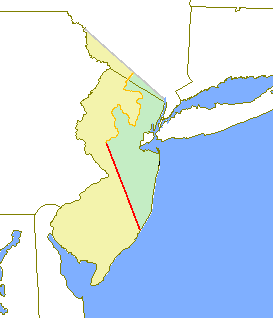
Even though the Dutch claimed South Jersey in 1609, they mostly used it for trading. In 1638, a group from New Sweden set up settlements along the Delaware River, including what are now Swedesboro and Bridgeport. The Dutch took over New Sweden in 1655, and then the British took control in 1667.
During the British colonial period, most of South Jersey was known as the Province of West Jersey from 1674 to 1702. This area was a special place for Quakers, a religious group who believed in peace and equality. Burlington became the capital of West Jersey in 1677, and Camden was founded in 1681. Since it was hard to travel far north on the Delaware River, most people lived along the southern part of the river. The line that separated West Jersey from East Jersey was important for land ownership and political borders until 1745. You can still see traces of this old border in some county lines today.
By 1700, about 70% of the people in West Jersey were Quakers from England or Ireland. Their beliefs in peace and fairness greatly influenced early New Jersey. In 1702, East and West Jersey were joined together under Queen Anne.
The American Revolution
During the American Revolution, many people in South Jersey, especially Presbyterians, resisted the British. Presbyterian leaders encouraged people to join the army. The Delaware River was very important during the war because it was used for trade and for defending Philadelphia. In September 1777, General Howe captured Philadelphia, and the British stayed there for 10 months. Quakers, however, were against the Revolution because of their belief in nonviolence.
South Jersey in the 1800s
For a long time, people thought South Jersey was only about farming. But in the 1700s, it was actually home to Wistarburg, the first successful glass factory in the colonies! After it closed, workers started new glass companies in towns like Millville and Glassboro. Recent discoveries show that South Jersey also played a big role in making iron, coal, building ships, and later, textiles. Other businesses included shoe makers, button makers, and rug companies. While many industries eventually slowed down, farming remained a big part of the economy.
The inner parts of South Jersey, like the New Jersey Pine Barrens and marshlands, stayed mostly empty because their sandy, acidic soil wasn't good for farming. Most cities were along the Delaware River, except for some small towns and beach resorts along the Jersey Shore.
Slavery was less common in South Jersey than in other parts of the state. This was because Quakers were against it, and there wasn't as much demand for slave labor. By 1810, there were only 328 enslaved people in South Jersey, compared to over 10,000 in the rest of New Jersey. Even though Black people still faced unfair rules, South Jersey became a safe place for former slaves. William Still, a famous African-American who helped slaves escape to freedom, was born in Burlington County.
Railroads started operating in South Jersey in the mid-1800s. The arrival of trains helped many towns grow. Many railroads later combined into the West Jersey and Seashore Railroad (WJ&S). Today, parts of this old system are still used for freight. A new light rail system, the Glassboro–Camden Line, is also being built.
The 1900s and Modern South Jersey
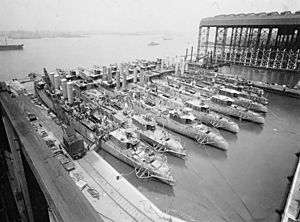
At the start of the 1900s, towns along the Delaware River saw more manufacturing because transportation and technology improved. In 1899, John Thompson Dorrance, a chemist for Campbell Soup Company, perfected his method of canning condensed soup. This made Campbell's soup much cheaper to ship and sell. The New York Shipbuilding Corporation opened its shipyard in Camden in 1900, becoming the world's largest shipyard by 1917. The Victor Talking Machine Company, founded in 1901, became a top producer of phonographs and records.
After World War II, many American cities, including those in South Jersey that relied on heavy manufacturing, saw factories close and people move away. The growth of suburbs was boosted by new highways, bridges, and more people owning cars. The New Jersey Turnpike opened in 1951, making it fast to travel between New York and Delaware. In 1955, William Levitt built what is now Willingboro, using a model that inspired other suburban developments. For example, Delaware Township in Camden County grew from about 10,000 people in 1950 to almost 65,000 by 1970, and was renamed Cherry Hill in 1961. While South Jersey's suburbs are generally middle-class, some older cities continue to work on improving their communities.
A Movement for Statehood
In 1980, a newspaper editor named Albert Freeman jokingly suggested that South Jersey should become its own state. But the idea gained popularity! On April 23, 1980, the town council of Egg Harbor even voted to support creating a new state of South Jersey. This movement was a way to get the attention of state lawmakers, especially about how money was spent. For example, people in the south felt that sports complexes were built in North Jersey, but the state didn't support projects like the Garden State Park Racetrack in the south. A vote was held in six counties in 1980, and 51 percent of voters said they wanted to separate and form a new state. Only Ocean County voted against it.
Economy and Living in South Jersey
In 2005, Money magazine called Moorestown the "best place to live" in the United States. It's a very nice area.
On the other hand, Camden has faced economic challenges. However, it is also a city with a lot of history and new developments, including major universities and a vibrant waterfront. Moorestown and Camden are connected by a central highway, NJ County Road 537.
Colleges and Universities
South Jersey is home to many great colleges and universities where students can continue their education:
- Cooper Medical School of Rowan University
- Georgian Court University
- Kean University-Ocean County campus
- Rowan University
- Rowan-Virtua School of Osteopathic Medicine
- Rutgers University–Camden
- Rutgers Law School
- Stockton University in Galloway Township and its campus in Stafford Township
Community Colleges
There are also several community colleges that offer a wide range of courses:
- Atlantic Cape Community College
- Camden County College
- Ocean County College
- Rowan College at Burlington County
- Rowan College of South Jersey, with campuses in Gloucester and Cumberland
- Salem Community College
Rutgers University also has smaller campuses at Atlantic Cape Community College and Camden County Community College. Plus, Rutgers has research stations in South Jersey, like the Philip E. Marucci Center for Blueberry and Cranberry Research and the Rutgers University Marine Field Station.
Sports in South Jersey
Many people in South Jersey cheer for Philadelphia professional sports teams like the Phillies (baseball), Eagles (football), Flyers (hockey), 76ers (basketball), and Union (soccer). In southern Ocean County, you'll find fans of both Philadelphia and New York sports teams.
While South Jersey doesn't have its own major league teams, the 76ers have held training camp at Stockton University and opened a practice facility on the Camden waterfront. The Flyers also practice in Voorhees.
South Jersey has been home to several minor league teams. The Jersey Shore BlueClaws baseball team plays in Lakewood and is connected to the Philadelphia Phillies. Minor league soccer is also played here, with the Ocean City Nor'easters based in Ocean City.
In 2007, the WNBA (women's basketball league) thought about adding a team in Atlantic City, but the new team eventually went to Atlanta.
South Jersey also used to have other minor league teams, like the Atlantic City Surf and Camden Riversharks in baseball, and the Atlantic City Boardwalk Bullies in ice hockey.
Shopping and Resorts
South Jersey has many great places to shop and visit. Key commercial centers include Cherry Hill, Camden, and Atlantic City. Atlantic City is famous for its resort casinos, boardwalk, shopping, and beautiful beaches.
Other popular Seaside resorts and commercial areas in South Jersey include:
Media in South Jersey
South Jersey is part of the Philadelphia television and radio market, meaning people usually watch and listen to stations from Philadelphia. Local newspapers include the Courier-Post, which calls itself "South Jersey's Newspaper" and focuses on Camden, Burlington, and Gloucester counties. The South Jersey Times covers Gloucester, Cumberland, and Salem counties.
Famous People from South Jersey
Many well-known people come from South Jersey, including actors, athletes, and musicians. Some famous South Jerseyans are Bruce Willis, Mike Trout, Kelly Ripa, Carl Lewis, and Carli Lloyd. You can find more about people from specific counties here:
- People from Atlantic County
- People from Burlington County
- People from Camden County
- People from Cape May County
- People from Cumberland County
- People from Gloucester County
- People from Ocean County (some consider this Central Jersey)
- People from Salem County
Culture and Unique Spots
South Jersey has many unique cultural places and businesses. Here are just a few:
- Absecon Light (a lighthouse)
- Adventure Aquarium
- Barnegat Light (another lighthouse)
- Batsto Village (a historic village)
- Blueberry farms in Hammonton
- Cape May Light (a lighthouse)
- Casinos in Atlantic City
- Clementon Amusement Park
- Commerce Bank
- Cooper River
- Cranberry bogs (where cranberries grow)
- Double Trouble State Park
- Garden State Park Racetrack
- Hadrosaurus (a type of dinosaur found here)
- Hereford Inlet Light (a lighthouse)
- Historic Smithville (a charming village)
- Indian King Tavern (a historic tavern)
- Island Beach State Park
- Jersey Devil (a local legend!)
- Jughandles (a special type of road turn)
- Lucy the Elephant (a famous elephant-shaped building)
- New Jersey Pine Barrens
- New Jersey Pinelands National Reserve
- Nipper Building (a historic building)
- Ocean City Boardwalk
- "On the Way to Cape May" (a popular song)
- Oyster Creek Nuclear Generating Station
- PATCO High Speed Line (a train)
- Perkins Center for the Arts in Moorestown and Collingswood
- Popcorn Park Zoo
- Shore Culture (the unique way of life at the beach)
- Six Flags Great Adventure (a theme park)
- Traffic circles (another type of road intersection)
- Surflight Theatre
- Tuckerton Seaport
- Walt Whitman House (home of a famous poet)
- Washington Street Mall
- WheatonArts (a glass and craft center)
- Wildwood Boardwalk
- USS New Jersey (a battleship museum)
South Jersey English: How People Talk Here
South Jersey is part of the Philadelphia dialect region. This means people here have a way of speaking that's similar to how people talk in Philadelphia.
Here are some common words and phrases you might hear in South Jersey:
- Hoagie: This is the usual name for a long sandwich, like what others might call a submarine sandwich.
- Wooder: People often pronounce the word "water" with a "wood" sound at the beginning.
- Jimmies: This word is used for the chocolate or rainbow sprinkles you put on cakes and ice cream.
- Down the shore: When people say they're going "down the shore," it means they're heading to the beach towns along the Jersey coast for fun.
- Shoobie: This is a slang term used by people who live at the shore all year round to describe visitors, especially those from Philadelphia or New York City, who come for vacation.



